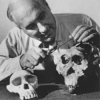Louis Leakey

Louis Leakey
Louis Seymour Bazett Leakey, also known as L. S. B. Leakey, was a Kenyan paleoanthropologist and archaeologist whose work was important in demonstrating that humans evolved in Africa, particularly through discoveries made at Olduvai Gorge with his wife, fellow paleontologist Mary Leakey. Having established a program of palaeoanthropological inquiry in eastern Africa, he also motivated many future generations to continue this scholarly work. Several members of Leakey's family became prominent scholars themselves...
NationalityBritish
ProfessionScientist
Date of Birth7 August 1903
CityKabete, Kenya
As a social anthropologist, I naturally accept and even stress the fact that there are major differences, both mental and psychological, which separate the different races of mankind. Indeed, I would be inclined to suggest that however great may be the physical differences between such races as the European and the Negro, the mental and psychological differences are greater still.
When my father arrived in Kenya, he had found the Kikuyu way of life similar to that of the British at the time the Romans invaded England 2,000 years ago.
Stone tools are fossilized human behavior.
I put a bullet into the back of the crocodiles neck just behind the head, thus killing it. If a crocodile is hit in any other part of its anatomy it disappears into the water and is irrecoverable.
Far too often animals are put to sleep when they could be saved through proper care and nursing.
Olduvai Gorge gives us one of the most remarkable stories of the past-the last chapter of the Earth's history, starting at the present day, right away back 2 million years.
People frequently ask me why I devote so much time to seeking out facts about man’s past…the past shows clearly that we all have a common origin and that our differences in race, colour and creed are only superficial.
Raising funds for my fourth expedition proved to be very difficult.
The crocodile was laid stomach upwards to be cut open. The stomach contents included bracelets, beads, necklaces, and indications of human meals.